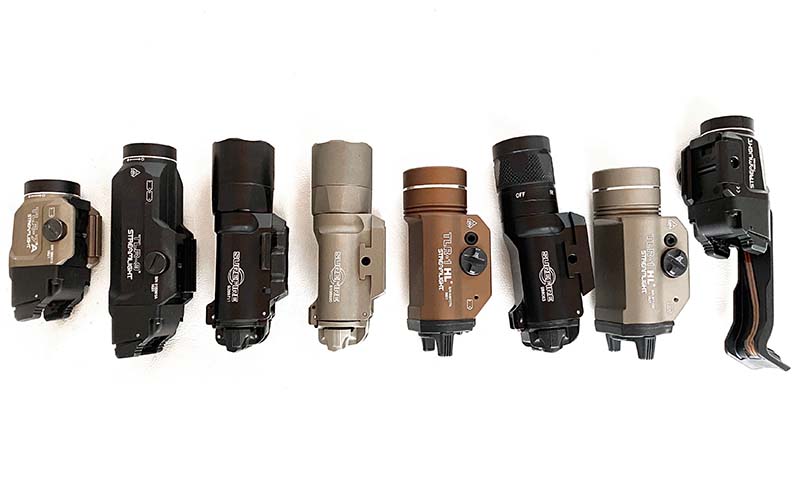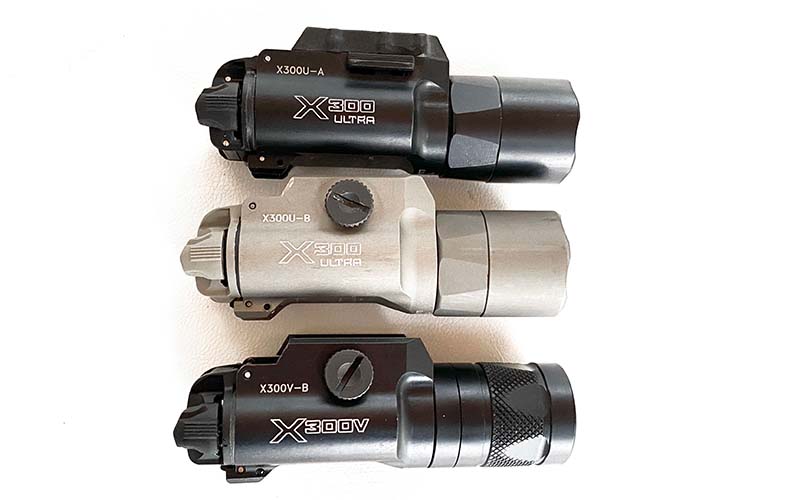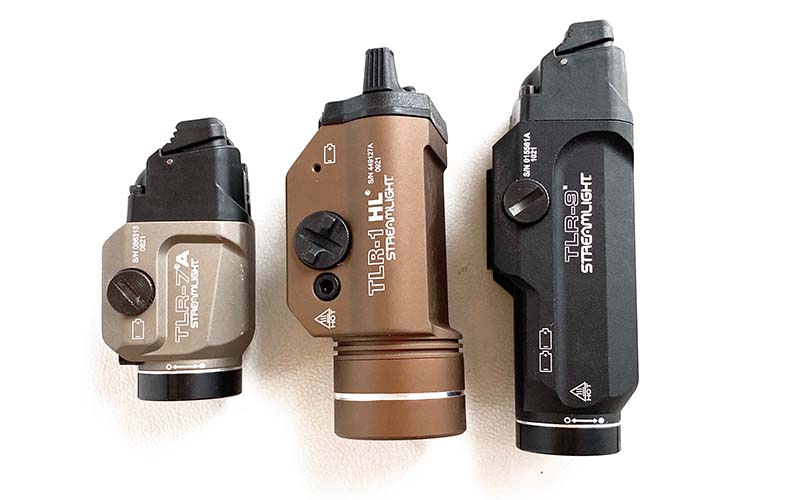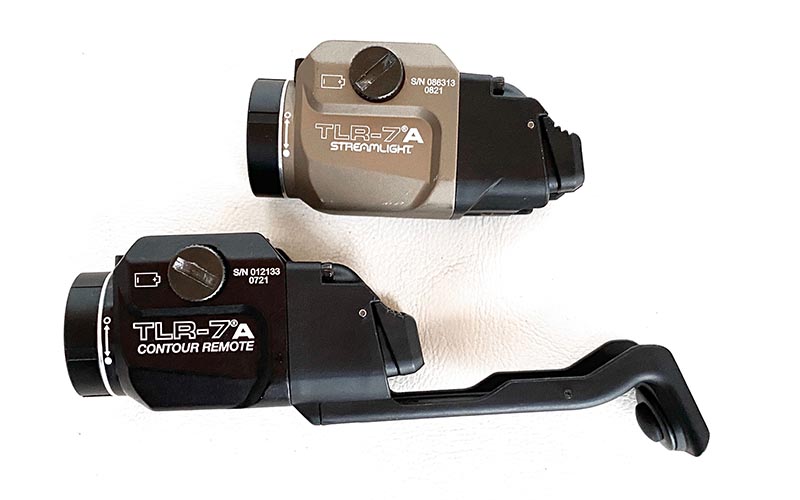The dark isn’t your friend, so here’s how to select the best weapon-mounted light for your needs.
The weapon-mounted light has become quite common in recent years, yet there’s still a great deal of confusion and disagreement between competing schools of thought. So, let’s shed some light on, well … lights.

Practicality Vs. Functionality
The main reason I divide handguns from rifles and shotguns in this discussion is based on the crucial factor of weight and real estate. It’s barely an afterthought to add a light to a shoulder arm, but it’s a deciding crossroads of utility on a handgun. It takes little, if any, imagination to mount a large, intense light onto a rifle these days; most modern handguards are covered in M-LOK mounting surfaces, in years past it was mil-spec Picatinny.
In fact, the minutia has taken over to the point that there are dozens of companies producing various means to manage your cables and pressure switches. Lights on rifles are nearly at a pinnacle; the science, while never truly settled, is in a comfortable rut, and I don’t see that changing for some time.
When it comes to handguns, there’s a much larger issue of practicality: Not every handgun needs a light, and not every light is an advantage, despite what supposed experts say. Yet, while my statement may seem reasonable, I’ve taken classes and participated in events where there’s an adamant stance to one extreme or another. I try to cover both points of view concerning weapon-mounted lights here, but I’m firmly in the camp that, for a light on a handgun to be effective, it must first not be a hindrance in daily use. It isn’t as simple as “lights good” or “lights bad.”
The essence of the handgun is that it must be a tool of action—its predictable function outweighing all other features in the moment of truth, whereas a rifle must be accurate at the foremost, otherwise it’s hardly worth its weight. Reliability in a handgun is the most critical feature: accuracy, capacity and power being secondary in no particular order. I don’t feel this is up for debate. I hardly imagine any reasonable person would advocate something like group size over reliability when life is on the line. If a light interferes with this baseline trait, it’s a no-go.
Weight and size are critical elements of function, just the same as capacity or safety type. I found that, for many gun owners, lights are almost a complete afterthought and added without a great deal of research. Not only can a light change the frontal weight and balance of a gun, but it can also add length and thus impact draw.
As an example, a common gun like the Glock 19 with a SureFire X300 light is as long as a 5-inch 1911. The 5-inch 1911, on the other hand, is unaffected in this capacity because the same X300 light doesn’t extend past the muzzle. Draw doesn’t really change much here.
I was at a media event a while back doing some coverage and ended up on this topic with some associates, a couple of them being professional instructors. Each of these guys claimed they wouldn’t even let students take the class unless they had a weapon-mounted light. “You’re not going to make it if you don’t have a light, plain and simple” was what I got out of that. I think this is false (not even all police departments issue lights on pistols, never mind the sheer number of civilians who defend themselves daily).
However, if you look at some classes available nationwide, you’ll see a trend to this type of thinking. Most classes I have been to advocated having at least two lights on your person, one as a stand-alone light and the other on the handgun. I can see the logic, but I don’t think it’s feasible for a person to do this 100 percent of the time. At some point, a person has to start accepting that there’ll be a cutoff in terms of how much gear they can put on a gun or their person and actually use it effectively.
Carrying a separate light is a better option, if you’re able to have it with you constantly, gun or not. I’ve become a convert to this in recent years and now carry a SureFire with Thyrm ring as a daily item—though I admit I don’t carry it if I expect to be home during daylight hours. If I’m out after dark I always have it, even if I don’t have a gun.
As a side note, for daily use I strongly recommend a rechargeable light, as I’ve probably paid for my flashlight many times over in batteries at this point but am too stubborn to order a new one with that capability. A handheld light is a great tool for life, and it really doesn’t need to be weapons-grade. If you’re prone to losing your stuff, the $10 gas station specials are often plenty bright and easily replaced.

On that note, a weapon-mounted light needs to be the opposite of cheap. In fact, I think that it must be as reliable as the gun, meaning that it should be 100 percent reliable in your experience with it. I really like SureFire and Streamlight on my pistols. I’ve never had a problem with any of them in terms of function, but I’ve broken a few in my time. Namely, I had a SureFire X300 that I lost the finger tabs on during a class with lots of drawing and holstering, and a Streamlight TLR-1 HL that had a faulty gasket on the battery compartment. I own a large number of these lights, and, overall, I count these as isolated problems.
I like my lights to be able to withstand impact if necessary, so I prefer a rugged mounting system as well. The SureFire X300U-A has a fast-attach feature, but I’ve also had my share of times in practice where the light went flying off the gun. For this reason, I prefer the X300U-B with the thumb screw-style mount. I use this on 1911s and typically save the A models for Glocks.
A good number of people have taken to Amazon to get their gun lights, and I’ve seen a wide number of mixed results. Many of my friends own Olight products; I’ve nothing against the brand at all and completely understand that some people are on a limited budget for accessories. Olight does make some very good products, and I count them as the best among the lower cost lights. That said, in most cases, it’s a good decision to save your money and buy once, cry once on a SureFire or Streamlight.
Notable Weapon-Mounted Lights to Consider
I’ve narrowed down my own lights to those that are only the most effective in realistic roles. My main rotation of pistols comprises 1911s, Glocks, J-Frame Smiths and a Sig P365.

My main field guns are 1911s; I like .45 ACP for serious use hunting and have had great success with them deer hunting. I carry SureFire X300U-B models on these guns, one being a custom-built hunting pistol and the other a Colt M45A1. The custom gun always has its light mounted, and my holsters for it are meant for the light. In general, I don’t carry the Colt with a light on it despite it having a rail. The gun is heavy already, and I don’t like the extra bulk—though when in the nightstand, I do put the SureFire back on.
I have four SureFire lights I use regularly, and they’ve proven extremely rugged. These are all “full-size” lights and are best when mounted on full-size 4.5- to 5.5-inch pistols. I prefer my lights to not protrude out in front of the muzzle, and on the 1911 this isn’t an issue.
For Glock pistols, I’m a fan of very compact lights, especially the Streamlight TLR-7. I have both the pressure switch version and the regular one. These tuck in neatly on a 4-inch Glock; I have one on both my regular carry G19 Gen 5 and my 19X with threaded barrel. I enjoy that, when using a suppressor, the compact light doesn’t make the Glock so front heavy as with a SureFire.

Of note is that I ended up swapping the pressure switch version from my 19 to the 19X after substantial use. The button lowers the finger noticeably on the 19, making it feel like a G26 grip. The 19X has a bit more real estate and allows for a firmer, full grip without the feeling of “stacking” your fingers up.
On my compact guns, such as the P365 and J-Frames, I don’t even try to mount a light on them. Instead, I want to take advantage of just how small and light they are. I know there are options for these guns, but I don’t want to negate the advantage of being able to easily drop them in a pocket.
I believe a light on a 3-inch 9mm or a 2-inch 357 Mag is just unnecessary; the distances these guns are effective is just too short for the added weight and is a liability for a fast draw from a pocket. A handheld is far better combined with a micro pistol.

Lights Out
Ultimately, there are many (too many?) schools of thought on the theory of lights. In terms of self-defense on the street, they can be great. But lights are also a beacon that gives you away, especially if you’re trying to hide or get away. In the home, they’re not always an advantage either, considering you’re just as likely to give your location away to an invader with one as you’d be turning your lights on in the room you’re in.
Moreover, few people practice inside their own home. I strongly encourage you to do so; your cozy domestic space can become a terrifying maze of moving shadows and blind corners in the dead of night. Making sure you know how to use your light in this scenario is important, and I’d even go so far as to say you should practice with a handheld light with your family and friends. The first time you do it you had best be ready for jump scares—even familiar faces are surprising when you don’t expect them to be in the room with you.
Editor’s Note: This article originally appeared in the April 2022 issue of Gun Digest the Magazine.
More On Tactical Lights:
 NEXT STEP: Download Your Free Storm Tactical Printable Target Pack
NEXT STEP: Download Your Free Storm Tactical Printable Target Pack
62 Printable MOA Targets with DOT Drills – Rifle Range in YARDS This impressive target pack from our friends at Storm Tactical contains 62 printable targets for rifle and handgun range use. Target grids and bullseye sizes are in MOA. Ideal for long-range shooting!
Subscribe to the Gun Digest email newsletter and we’ll send your print-at-home target pack right away. Just enter your email address below.

